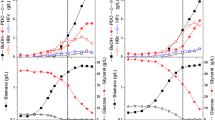Abstract
A comprehensive metabolic network was proposed forAlcaligenes faecalis and employed in a stoichiometrically based flux balance model for curdlan production optimization. The maximal yield of curdlan was evaluated for curdlan batch production. Various metabolic structures and metabolic pathway distributions related with the curdlan maximal yield was evaluated. The results showed that the energy efficiency rather than the substrate supply was the major constraint for the enhancement of curdlan production. The increase in specific rate of glucose uptake could enhance curdlan production yield due to the decrease of the ratio of metabolic maintenance to substrate consumption. However, some of the energy loss and nutrient limitation associated with the increase of metabolic maintenance would adversely affect the conversion efficiency of the substrate.
Similar content being viewed by others
Abbreviations
- 6-P-G:
-
6-Phosphogluconate
- AcCoA:
-
Acetyl coenzyme A
- DHAP:
-
Dihydroxyacetone-phosphate
- DCW:
-
Dry cell weight
- F-6-P:
-
Fructose-6-phosphate
- FDP:
-
Fructose-1,6-bisphosphate
- G-1-P:
-
Glucose-1-phosphate
- G-6-P:
-
Glucose-6-phosphate
- GAP:
-
Glyceraldehyde-3-phosphate
- KDPG:
-
2-Keto-3-deoxy-6-phosphogluconate
- PEP:
-
Phosphoenolpyruvate
- PQQ:
-
Pyrroloquinoline quinine
- PQQH2 :
-
Dihydroquinone PQQ
- PYR:
-
Pyruvate
- Ri-5-P:
-
Ribose-5-phosphate
- TCA:
-
Tricarboxylic acid cycle
- UDPG:
-
UDP-glucose
- Lipid-P:
-
Isoprenoid lipid-phosphate
- Lipid-P-G:
-
Isoprenoid lipid-phosphoglucose
References
Harada, T. (1977) Production, properities, and application of curdlan. pp. 265–283. In: P. A. Sanford and A. Laskin (eds.).Extracellular Microbial Polysaccharides. American Chemical Society, Washington DC, USA.
Sutherland, I. W. and D. C. Ellwood (1979) Microbial exopolysaccharide-industrial polymers of current and future potential. pp. 107–150. In: A. T. Bull, D. C. Ellwood, and C. Ratledge (eds.).Microbial Technology. Society for General Microbiology, London, UK.
Lee, I. Y., M. K. Kim, J. H. Lee, W. T. Sec, J. K. Jung, H. W. Lee, and Y. H. Park (1999) Influence of agitation speed on production of curdlan byAgrobacterium species.Bioprocess Eng. 20: 283–287.
Lee, J.-H. and I. Y. Lee (2001) Optimization of uracil addition for curdlan (β-1→3-glucan) production byAgrobacterium sp.Biotechnol. Lett. 23: 1131–1134.
Kim, M.-K., I.-Y. Lee, J.-H. Ko, Y.-H. Rhee, and Y.-H. Park (1999) Higher intracellular levels of uridinemonophosphate under nitrogen-limited conditions enhance metabolic flux of curdlan synthesis inAgrobacterium species.Biotechnol. Bioeng. 62: 317–323.
Zarnt, G., T. Schrader, and J. R. Andreesen (1997) Degradation of tetrahydrofurfuryl alcohol byRalstonia eutropha is initiated by an inducible pyrroloquinoline quinone-dependent alcohol dehydrogenase.Appl. Environ. Microbiol. 63: 4891–4898.
Schleicher, E. and H. Simon (1977) The stereochemical course of the hydrogen transfer to NAD, catalyzed by bacterial glucose dehydrogenase and hydrogenase ofAlcaligenes eutrophus H 16.FEBS Lett. 74: 269–271.
Letisse, F., P. Chevallereau, J. L. Simon, and N. Lindley (2002) The influence of metabolic network structures and energy requirements on xanthan gum yields.J. Biotechnol. 99: 307–317.
Sawyer, M. H., P. Baumann, and L. Baumann (1977) Pathways of D-fructose and D-glucose catabolism in marine species ofAlcaligenes, Pseudomonas marina, andAlteromenas communis.Arch. Microbiol. 112: 169–172.
Wang, L., X. B. Zhan, Y.-H. Zhu, Z.-Y. Li, and Y. Yang (2002) Influence of pH control on the production of curdlan byAlcaligenes faecalis strain.Chin. J. Biotechnol. 18: 634–637.
Sumner, J. B. and G. F. Somers (1949) Dinitrosalicylic method for glucose. pp. 38–39. In: J. B. Sumner and G. F. Somers (eds.).Laboratory Experiments in Biological Chemistry. Academic Press, New York, NY, USA.
Harwood, J. E. and D. J. Huysen (1970) Automated analysis of ammonia in water.Water Res. 4: 695–704.
Goosen, N., D. A. Vermaas, and P. van de Putte (1987) Cloning of the genes involved in synthesis of coenzyme pyrroloquinoline-quinone fromAcetinobacter calcoaceticus.J. Bacteriol. 169: 303–307.
Anderson, G. L., M. Love, and B. K. Zeider (2003) Metabolic energy from arsenite oxidation inAlcaligenes faecalis.J. Phys. IV 107: 49–52.
Hoke, K. R., N. Cobb, F. A. Armstrong, and R. Hille (2004) Electrochemical studies of arsenite oxidase: an unusual example of a highly cooperative two-electron molybdenum center.Biochemistry 43: 1667–1674.
Shuler, M. L. and F. Kargi (2002) How cells grow. pp. 155–175. In: M. L. Shuler and F. Kargi (eds.)Bioprocess Engineering: Basic Concepts. Prentice Hall PTR, NY, USA.
Phillips, K. R. and H. G. Lawford (1983) Theoretical maximum and observed product yield associated with curdlan production byAlcaligenes faecalis.Can. J. Microbiol. 29: 1270–1276.
Varma, A., B. W. Boesch, and B. O. Palsson (1993) Stoichiometric interpretation ofEscherichia coli glucose catabolism under various oxygenation rates.Appl. Environ. Microbiol. 59: 2465–2473.
Gottschalk, G. (1979)Bacterial Metabolism. pp. 51–68. Springer-Verlag, New York, NY, USA.
Lawford, H., J. Keenan, K. Phillips, and W. Orts (1986) Influence of bioreactor design on the rate and amount of curdlan-type exopolysaccharide production byAlcaligenes faecalis.Biotechnol. Lett. 8: 145–150.
Author information
Authors and Affiliations
Corresponding author
Rights and permissions
About this article
Cite this article
Zheng, ZY., Lee, J.W., Zhan, X.B. et al. Effect of metabolic structures and energy requirements on curdlan production byAlcaligenes faecalis . Biotechnol. Bioprocess Eng. 12, 359–365 (2007). https://doi.org/10.1007/BF02931057
Received:
Accepted:
Issue Date:
DOI: https://doi.org/10.1007/BF02931057




